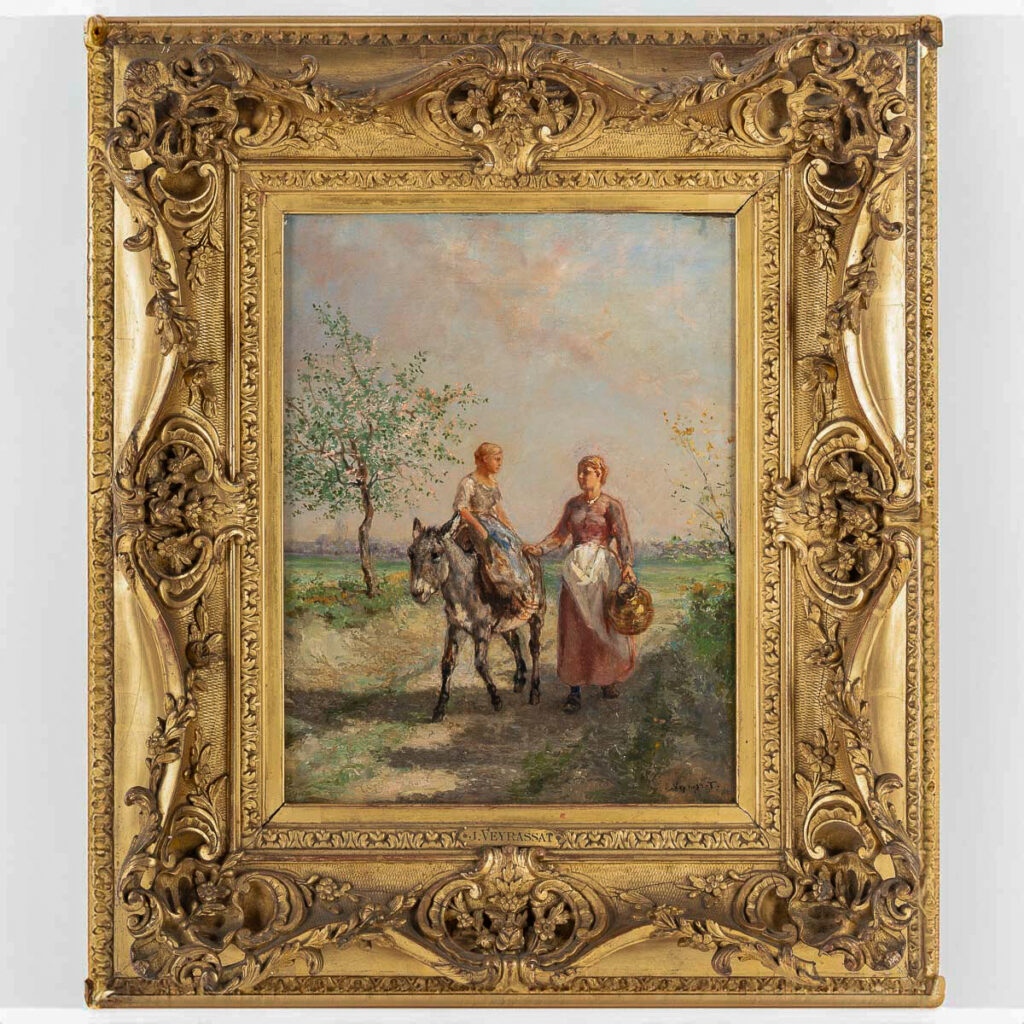Jules Jacques VEYRASSAT (1828-1893) Donkey ride oil on canvas circa 1860.
Jules Jacques Veyrassat is a magnificent painter, sought after by collectors and art lovers alike.
A fine painting, a realistic vision of country life near Barbizon in the mid-19th century. The color palette suggests romanticism, the sweetness of life, simplicity, and beauty.
Our painting signed lower right, is perfectly served by its beautiful original gilded wood frame.
Beautiful Barbizon school of the mid-nineteenth century, circa 1860.
Sizes unframed: H 13.77 In. - W 10.62 In.
Sizes with frame: H 21.25 In. - W 18.11 In.
In fine original condition, it is served by its beautiful 19th-century carved wood and gilded stucco frame.
Biography:
Jules Jacques Veyrassat, born April 12, 1828, in Paris and died July 2, 1893, in the same city, was a French painter and engraver of the Barbizon School.
Jules Jacques Veyrassat studied in Henri Lehmann's workshop in Paris and exhibited his first works at the Salon in 1848.
Veyrassat made a name for himself in France with his paintings and attracted attention when he began working as an engraver in the 1860s.
Between 1866 and 1869, his engraving work earned him several medals. The British scholar Philip Gilbert Hamerton asked him to collaborate on several of his books on the art of engraving: Chapters on Animals (1874) with Karl Bodmer, Etching and Etchers (1880), and a third edition with other artists.
He received a medal for his painting in 1872.
Veyrassat was named Chevalier de la Légion d'Honneur in 1878. He is one of the most awarded painters and engravers for his work on nature.
He was associated with the Ecouen school, where he had a room, and attended classes given by Pierre-Edouard Frère, whom he befriended. It was Pierre-Edouard Frère and Charles-François Daubigny who encouraged him to take up etching.
He is also associated with the Barbizon school. His work is close to that of Charles Jacque and Jean-François Millet, whom he knew well. In a realist vein, his work is based on observations of rural life in deepest France at the time. His subjects include breeding and the work of horses in agricultural life. He never left his homeland, but his reputation spread throughout Europe.
Jules Jacques Veyrassat died on July 2, 1893, in the 9th arrondissement of Paris, and is buried in the Père Lachaise cemetery (44th division).
Public collections:
États-Unis.
Baltimore, Walters Art Museum : Femme et enfant agenouillés devant une croix.
San Francisco : De Young Museum ; Legion of Honor.
Williamstown, Clark Institute.
France.
Bézier, Musée des Beaux-Arts : Les Cascarrottes au lavoir, 1863.
Chartres, Musée des Beaux-Arts : Le Repas des moissonneurs, 1862, huile sur toile, 121,5 × 239 cm (Inv. 88.11.1).
Dijon, Musée des Beaux-Arts : Vue d’Auxerre.
Grenoble, Musée de Grenoble : La Fenaison.
La Roche sur Yon, Musée Municipal : Fontaine à Hendaye.
Paris : Musée du Louvre. Musée d’Orsay. Musée du Quay Brandy Jacques Chirac.
Pau, Musée des Beaux-Arts : Chevaux de halage sur la Seine.
Péronne, Musée Alfred-Danicourt : Chevaux au labour.
Reims, Musée des Beaux-Arts : Les Moissonneurs ; La Meule ; Chevaux de halage ; Cour de ferme ; La Moisson.
Rennes, Musée des Beaux-Arts : Le Chargement de la charrette.
Rouen, Musée des Beaux-Arts : Étude algérienne, dite aussi Scène arabe.
Soissons, Musée de Soissons : Cour de ferme.
Toulouse, Musée des Augustins.
Royaume-Uni.
Manchester, Manchester Art Gallery.




